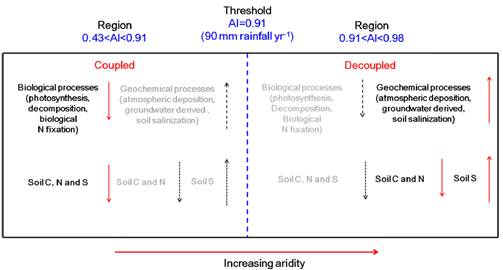发现北方草原生态系统硫循环影响机制


中科院沈阳应用生态所首次揭示了中国北方干旱和半干旱草原生态系统硫循环的影响机制,提出干旱指数达0.91时为该区域硫循环的分界值,在此分界两侧硫循环具有不同的影响机制。这为生物地球化学元素循环模型的建立提供了新思路。相关成果日前发表于《生物地球化学》。
硫元素在植物生长发育方面发挥着重要作用。在全球气候变化背景下,陆地生态系统生物地球化学过程与地球化学循环过程的权衡关系势必会发生变化,影响土壤硫分布格局及其与碳、氮的关系,进而影响生态系统的结构与功能。
研究人员依托我国北方草地样带调查,通过国际合作研究,重点分析气候变化对土壤硫元素分布格局及其与碳、氮关系的影响,并着力阐明其内在过程与机制。他们发现,在干旱度指数等于0.91时,土壤有效硫空间格局及其与碳、氮关系发生了明显的变化。在较湿润地区(干旱指数小于0.91),随着干旱度指数增加,土壤有效硫含量逐渐降低,土壤有效硫含量与碳、氮含量呈显著正相关关系。在较干旱地区(干旱指数大于0.91),随着干旱指数的增加,土壤有效硫含量反而升高,土壤有效硫含量与碳、氮含量失去相关关系。(来源:中国科学报 彭科峰)
A threshold reveals decoupled relationship of sulfur with carbon and nitrogen in soils across arid and semi-arid grasslands in northern China
Abstract How climatic factors influence the balance of sulfur (S) with carbon (C) and nitrogen (N) in soils is not well understood. Here we report the results of S, C and N concentrations in 550 soil samples along a 3500-km aridity gradient across arid and semi-arid grasslands in northern China. Our results showed that soil available S (AS) concentrations decreased with increasing aridity index (AI, calculated as ‘1—the ratio of mean annual precipitation to potential evapotranspiration’) when AI < 0.91 (90–450 mm rainfall year−1), but increased when AI > 0.91 (30–90 mm rainfall year−1), having a threshold at AI = 0.91 (90 mm rainfall year−1). Soil AS concentrations were positively related to soil organic C (OC), soil total N (TN), microbial biomass C and N concentrations, and arylsulphatase activities when AI < 0.91, but were not positively related to these variables when AI > 0.91. Topsoil AS:OC and AS:TN ratios mainly depended on OC and TN concentrations when AI < 0.91, but mainly depended on AS concentrations when AI > 0.91. The decreased (AI < 0.91) and increased total S concentrations (AI > 0.91) with increasing AI along the gradient provided further evidence for the existence of this fundamental threshold. High concentrations of sulfate in drier soils were associated with long-term atmosphere inputs and groundwater-derived salts with minimal leaching rates. Overall, our findings imply that aridity asymmetrically controls the relationships of soil AS with OC and TN on the two sides of the threshold, i.e. biological processes exerted stronger controls in wetter sites, while geochemical processes played more significant roles in drier sites. These results should be incorporated into predictive models of global biogeochemical cycling under various global climate change scenarios.
原文链接:http://link.springer.com/article/10.1007%2Fs10533-015-0174-4

